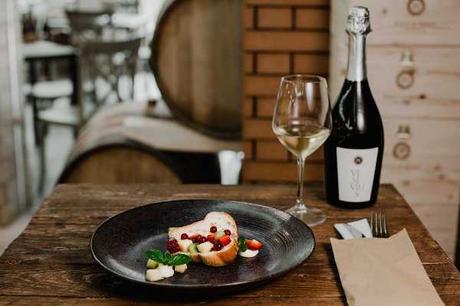
Bosco de’ Medici Winery
The fermentation of wine may have been picked up in Ancient Greece, however, it was the Ancient Romans that mastered the mass production of the alcoholic beverage. The wine was considered an integral part of the daily diet of the ancient people, only surpassed by water and milk. It was a drink that even slave’s and women could have, and it is said that for every citizen, a bottle of wine was drunk a day. Whilst women could only drink small amounts of the sweet wine, men could drink however much they wanted. You may wonder how the entire population was not inebriated at all times of the day, and this is due to the fact that the wine was weakened by mixing it with sea water. The wine was safer to drink than water as the alcohol in it counteracted for the bacteria found in the water. The Romans turned the production of winemaking into such a profitable business due to their low-cost methods of production.
The amount of money you spent on wine contributed to your status in Roman society, and it was white wine that the people preferred. The saw red wine as an inferior variation, only drank by soldiers and the poor. In fact, it wasn’t until much later that Romans began to accept red wine, but even then, it was not the deep ruby red shades we drink today, but closer to what we know as rose. It was extremely difficult to drink straight due to its vinegary and bitter taste, however, the Barbarians are thought to have done this. Instead, Romans mixed their wines with herbs and spices, or honey which was called muslum wine. As a result of these mix ins, wine was used medicinally to cure depression, vertigo, and tapeworms.
Winemaking in Pompeii was a lucrative industry and the hub of wine production in the whole of Europe. The people worshipped Bacchus, the God of wine, as evident by the many frescoes that he is depicted on. Their loyalty to the God was so devout that there was a cult of followers who followed Bacchus. In one of the more cryptic properties of Pompeii, the cult of Bacchus, known to the Ancient Greeks as Dionysus, is portrayed in a large fresco, where it is seen that a member is being initiated into this secretive cult. Make no mistake however, there was more to this group than just drinking, they were all deeply spiritual and had to attend many ceremonies and rituals to appease Bacchus.
The proximity to Vesuvius meant that the soil was extremely fertile, combined with the Southern Italian warm temperatures, it became the perfect location for planting grapes. After the grapes were harvested, slaves would stomp on them by foot and then place them in terracotta pots where they were then buried in the ground. The pots were left open during fermentation, however, unlike the wine of today, were only matured for a few months before they were served. The terracotta pots they were held in were called amphorae, each pot with their own label that showed the place of origin and what type of wine it is. We also know now that all amphorae varied in style depending on where they were from, which helps researchers determine the country of origin.
Many residents of Pompeii had patches of land connected to their houses with vines in it, in fact, it is reported that approximately two-thirds of the villas had their own vineyards. The most popular wine was local, from Campania. This variety was called Falernus, which produced the area’s most famous wine- Falerian. It was the most expensive wine in the Empire and was a sweet white wine with the highest percentage of alcohol available at the time, which was 16%. At the House of Amarantus, a wine shop in Pompeii, over 30 amphorae were found with over 8 grape varieties used. Some of these included Greco, Fiano and Piediross. It is also known that the locals imported wines from Crete, Sicily and for the wealthier members of society; Turkey.
In one particular era of the Roman Empire, Emperor Domitian issues a decree banning some vineyards as the people were starving, and farmers were planting vines instead of wheat. After Vesuvius erupted, the vineyards were destroyed making wine extremely expensive and only available to the wealthy who could afford the imported wines.
Thanks to casts of the vines made by 19th century archaeologist Giuseppe Fiorelli and the Ancient Roman scholar Pliny the Elder’s book ‘Naturalis Historia’, a team of researches and the winemakers behind Mastrobeardino began a project in the 1980’s to restore the ancient vineyards of Pompeii. Due to the in-depth description of that varieties written about in Pliny’s book, and the frescoes in Pompeii that distinguish what grapes were used, researches have been able to plant the right grapes in the same style as the Romans.
Whilst they are mostly sticking to the techniques that the Ancient Romans used, the process has been modified to suit the tastebuds of modern society. The Falerian wine once heavily enjoyed by citizens of Pompeii can now set you back over a hundred dollars for a liter and can be found by the bottle in high end restaurants. If the price tag of Falerian wine seems a little high to you, you can always do the next best thing which is visit Pompeii! While you may picture the ruins as a vast site with solely buildings and frescoes, this isn’t the case. Since the excavations, the fertile soil has begun producing again, with many green vineyards on the rise due to the diligence and research of the archaeological society and Mastrobeardino winemakers.
Recommended Pompeii Tours: Pompeii Tour from Rome
Price: €129
Tour Company: Sightseeing Tours Italy
This post was originally posted on https://sightseeingtoursitaly.wordpress.com/2019/09/04/wine-in-ancient-pompeii/

